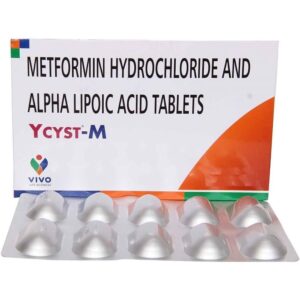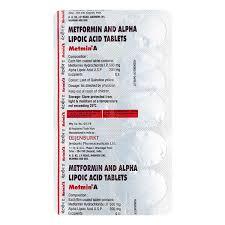METFORMIN + ALPHALIPOIC ACID
Metformin: Metformin is a commonly prescribed oral medication used to treat type 2 diabetes. It belongs to the class of drugs known as biguanides. Metformin helps to control blood sugar levels by reducing the amount of glucose produced by the liver and by improving the body’s response to insulin. It is also sometimes used in the treatment of polycystic ovary syndrome (PCOS).
The recommended starting dose of metformin for adults is usually 500 mg or 850 mg once daily, taken with meals. The dose may be gradually increased, if needed, to a maximum of 2,000 mg per day, divided into two or three doses. However, the exact dosage and frequency may vary depending on individual patient factors and the judgment of the prescribing doctor.
Common side effects of metformin include gastrointestinal symptoms such as diarrhea, nausea, vomiting, and abdominal discomfort. These side effects are usually temporary and can often be minimized by taking the medication with meals. In rare cases, the drug may also cause a potentially life-threatening condition called lactic acidosis, characterized by symptoms such as rapid breathing, muscle pain, weakness, dizziness, and stomach pain. It is important to seek immediate medical attention if any of these symptoms occur.
Other potential side effects of metformin may include loss of appetite, metallic taste in the mouth, low blood sugar (if combined with other diabetic medications or insulin), and vitamin B12 deficiency. It is important to consult with a healthcare professional for an accurate diagnosis and appropriate dosage adjustments if any side effects occur or if there are any concerns regarding the use of metformin.
Alphalipoic Acid: Alphalipoic Acid (ALA) is a naturally occurring compound that is synthesized in small amounts by the body. It is also available as a dietary supplement. ALA has various therapeutic uses and is commonly used as an antioxidant.
The primary use of ALA is in the treatment of neuropathy associated with diabetes. It has been found to improve symptoms such as numbness, tingling, and burning sensations in the extremities. ALA is also used in the management of diabetic neuropathy-related pain.
The exact mechanism of action of ALA is not fully understood. However, it is believed to function as an antioxidant, protecting cells from damage caused by free radicals. ALA can directly scavenge free radicals and recycle other antioxidants, such as vitamins C and E. Additionally, ALA has anti-inflammatory properties and can improve blood flow to affected areas.
The recommended dose of ALA for neuropathy associated with diabetes is usually between 300 to 600 mg per day, taken orally. The dose may vary depending on individual needs and the severity of symptoms. It is recommended to take ALA with meals to improve its absorption.
Side effects of ALA are generally mild and uncommon. Common side effects may include gastrointestinal symptoms such as nausea, stomach discomfort, and vomiting. In rare cases, individuals may experience allergic reactions or skin rashes. ALA may also lower blood sugar levels, so caution should be exercised in patients with diabetes, especially if taking medications to lower blood sugar. It is advisable to consult with a healthcare professional before starting ALA or adjusting the dose.
Overall, ALA is a safe and well-tolerated supplement when used as directed. However, it is important to note that ALA should not be used as a substitute for medical treatment. Individuals with underlying health conditions or those taking other medications should consult with a healthcare professional before starting ALA.



